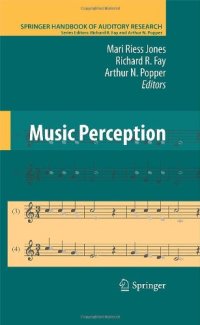
Ebook: Music Perception
- Genre: Psychology
- Tags: Otorhinolaryngology, Neurosciences, Cognitive Psychology, Acoustics
- Series: Springer Handbook of Auditory Research 36
- Year: 2010
- Publisher: Springer-Verlag New York
- Edition: 1
- Language: English
- pdf
This volume presents an overview of a relatively new field of psychoacoustic and hearing research that involves perception of musical sound patterns. The material is considered in a set of chapters that reflect the current status of scientific scholarship related to music perception. Each chapter aims at synthesizing a range of findings associated with one of of several major research areas in the field of music perception.
Overview Mari Riess Jones, Richard R. Fay, Arthur N. Popper
Music Perception: Current Research and Future Directions Mari Riess Jones
The Perception of Family and Register in Musical Notes Roy G. Patterson, Etienne Gaudrain, and Thomas C. Walters
A Theory of Tonal Hierarchies in Music Carol L. Krumhansl and Lola L. Cuddy
Music Acquisition and Effects of Musical Experience Laurel L. Trainor and Kathleen A. Corrigall
Music and Emotion Patrick G. Hunter and E. Glenn Schellenberg Tempo and Rhythm J. Devin McAuley Neurodynamics of Music Edward W. Large
Memory for Melodies Andrea R. Halpern and James C. Bartlett
About the Editors:
Mari Riess Jones is Full Professor in the Department of Psychology at The Ohio State University, Columbus, and Adjunct Professor of Psychology at the University of California, Santa Barbara. Arthur N. Popper is Professor in the Department of Biology and Co-Director of the Center for Comparative and Evolutionary Biology of Hearing at the University of Maryland, College Park. Richard R. Fay is Director of the Parmly Hearing Institute and Professor of Psychology at Loyola University of Chicago.
About the Series: The Springer Handbook of Auditory Research presents a series of synthetic reviews of fundamental topics dealing with auditory systems. Each volume is independent and authoritative; taken as a set, this series is the definitive resource in the field.
The increasing prevalence of musical stimulation in our everyday environment makes studies of musical listening, comprehension and memory important. Music has simply become a pervasive aspect of the experienced environment for most of us; along with enhanced levels of machine sounds, musical sound sources are contributing to a virtual transformation of contemporary soundscapes occurring in many industrial countries. In spite of such trends, arguably the mainstream research in psychology and related fields has been slow to devote concentrated attention to this phenomenon and what it might mean. As a result, with respect to more established fields of research (e.g., visual perception, speech perception, attention and memory etc.), less is known about how people perceive and respond to complex, non-random, acoustic signals found in musical events. Although these topics reside in the domain of music research, this field is a relatively new one, with a history that dates back only about 25 years. Nevertheless, it is now a vibrant and rapidly growing field that draws from multiple disciplines (psychology, psychoacoustics, computer science, music theory, and so forth) to seek answers to questions about how we listen to musical events in our world. It tackles questions about pitch perception in complex patterns, about the role of tonal schemes as well as effects of metrical and rhythmic schemes on musical listening behaviors. It also examines abilities of children and adults to perceive and comprehend dynamic sound patterns. Emotional responses to music are also studied; and overarching all of this are exciting new neuroscience findings concerned with neural responses to musical events. Music Perceptionintroduces its audience to these and related basic issues concerned with listening to music. It also illustrates how knowledge about music perception may ultimately lead to a broader understanding of conventional concepts regarding perception, attention and memory.